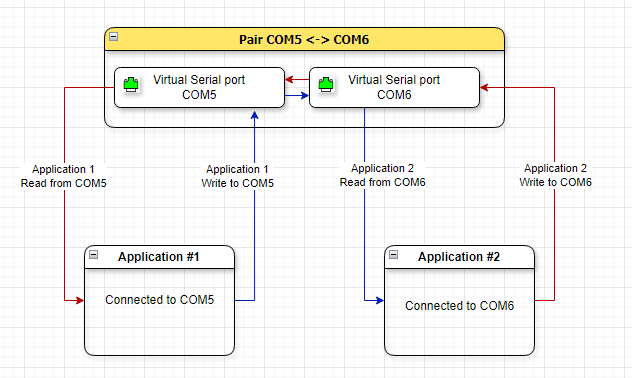Purpose: connect 2 applications/flows (or more if the specified number of lanes is greater than 1).
Pair device creates 2 connected virtual COM ports.

Data flow diagram

Pair settings
- "Number of pair lanes": (for experienced users only!) specifies number of lanes Pair should handle. Default value is 1, max number is 16. If you have more than 1 lane, the same virtual COM port can be opened multiple times with separate lane assigned on every open event. If you are not sure what this parameter does, just leave it as default value 1.
- "Emulate baud rate": enable baud rate emulation for read requests.
- "Override timeouts": (for experienced users only!) override serial timeouts for selected virtual ports. Occasionally, it may be useful to improve compatibility with some applications (for example, when additional delays are introduced when sending traffic over network). See Override virtual port timeouts for more details.
- "Always queue write requests": if enabled, all write requests will always be put in the queue for delayed processing. Less efficient but may be useful for compatibility with some applications. If enabled, Baud rate emulation is disabled.
- "Write requests processing disabled if both clients are not connected": if checked, VSPE will immediately "succeed" write requests if Connector does not have both clients connected. This can be useful if the only connected application writing to the COM port does not use write timeouts and you do not want to block write calls.
- "Notify about remote client connection/disconnection": if checked, VSPE virtual port will generate EV_EVENT1 on remote client connect and EV_EVENT2 on remote client disconnect.
- "Allow buffer overruns": if checked, write requests will succeed without writing data if remote input buffer is full.
- "Reset modem registers on close": if checked, RTS/DTR modem registers are reset and propagated to peer on close.
- "Purge buffers on open": If enabled, virtual COM port buffers will be purged on open
- "Purge buffers on close": If enabled, virtual COM port buffers will be purged on close
You can also define custom pinout for virtual COM ports.
Example: configuring and using pair lanes
- Create Pair COM1 -> COM2 with 3 pair lanes
- Connect App A1 to COM1
- Connect App A2 to COM1
- Connect App A3 to COM1
- Connect App B1 to COM2
- Connect App B2 to COM2
- Connect App B3 to COM2
- Now, the following apps are connected: A1 -> B1, A2 -> B2, A3 -> B3
Some applications may require "Always queue write requests" option to work properly.
Lanes are using shared processing thread.
This means that if Pair device has a large number of lanes
and heavy traffic, delays may occur.
- See also:
-



